The "Corporate Campaign" Strategy
Helping Labor Unions and Public Interest Groups Confront Unbridled Corporate and Political Greed since 1981
Learn More
Helping Labor Unions and Public Interest Groups Confront Unbridled Corporate and Political Greed since 1981
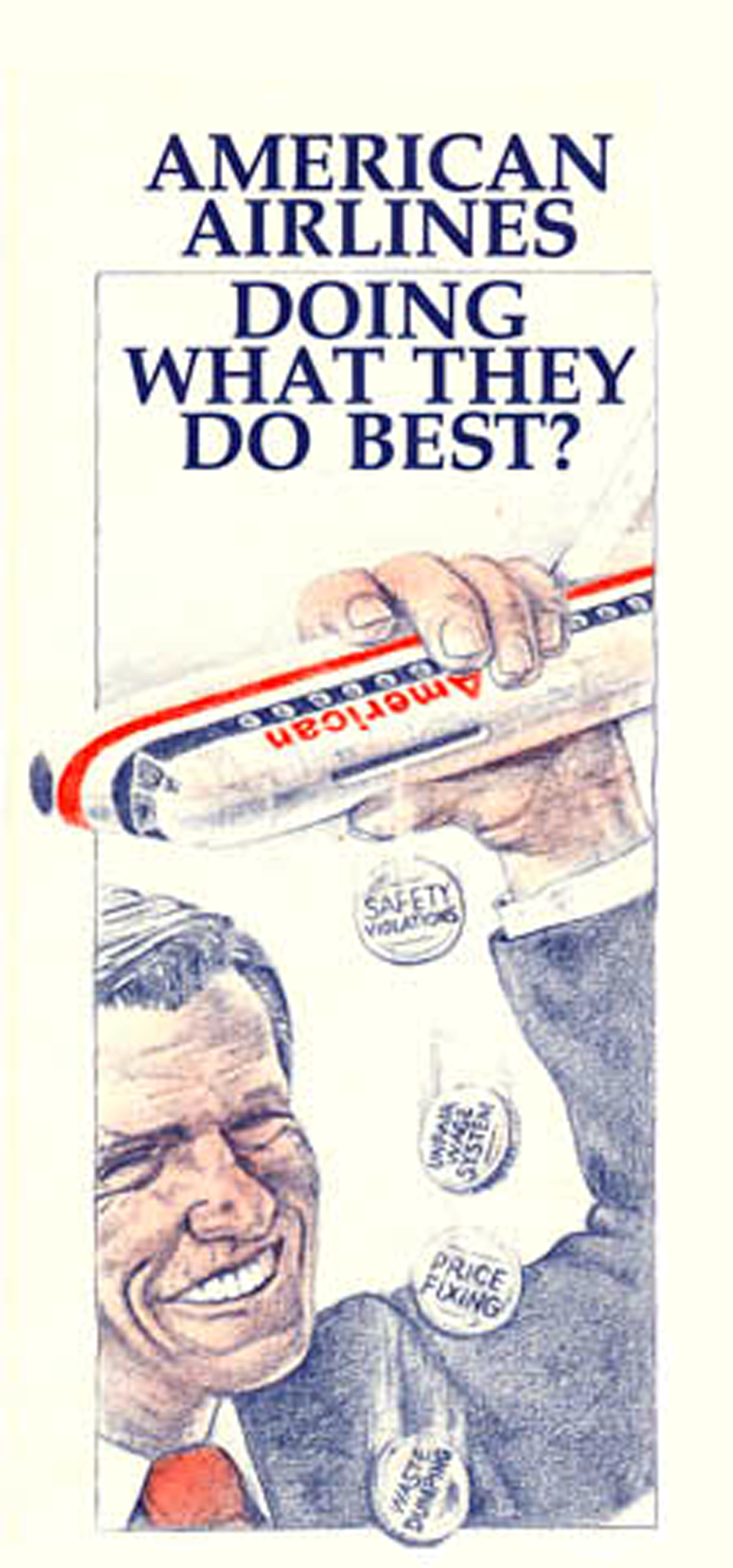
Cover of CCI produced brochure.
The Wall Street Journal (March 25, 1987), in an article headlined, "American Air Attendants Seek to Topple Two-Tier Pay," reported: "The American dispute...is a test of the union's strategy, the corporate campaign and of the architect of that tool, Ray Rogers, who the attendants have hired..." The article added, "Soon after Mr. Rogers' role...was disclosed, American sued the union in federal court...(alleging) that the union, by using a corporate campaign, isn't bargaining in good faith."
The Association of Professional Flight Attendants (APFA) began developing its corporate campaign in late 1986 after CCI had researched sensitive issues and vulnerabilities in the company's financial and political support network. First came a major, ongoing effort, on which CCI organizer Susan Hibbard worked tirelessly with the APFA to build internal union solidarity by educating and activating members on the issues. Each month, the union publication Skyword featured articles exposing aspects of the company and its policies that American would have preferred to keep under wraps. The information was presented in ways calculated to make corporate policymakers increasingly uneasy and concerned.
CCI looked into the performance record of AMR management, and found a history of questionable practices. This information was included in various pieces of campaign literature designed to let the public and airline know about the many instances of mismanagement at American. The company wanted the media to portray the dispute as one around the issue of the corporate catchphrase, "We must remain competitive." By raising these other concerns, the union turned the tables. Through its corporate campaign, it brought widespread attention to the real issues, two-tier and corporate irresponsibility.
On March 22, 1987, APFA began reaching out to the public with mass distribution of a brochure entitled, "American Airlines, Doing What They Do Best." It documented American's safety violations, toxic waste dumping, unfair labor policies and involvement by its CEO in price-fixing efforts. The company was so irate that it illegally fired 17 flight attendants within hours after they distributed brochures to travelers at the Dallas-Ft. Worth Airport. Compounding the company's problems was the fact that the brochure and its contents were highlighted on the ABC News program "Nightline."
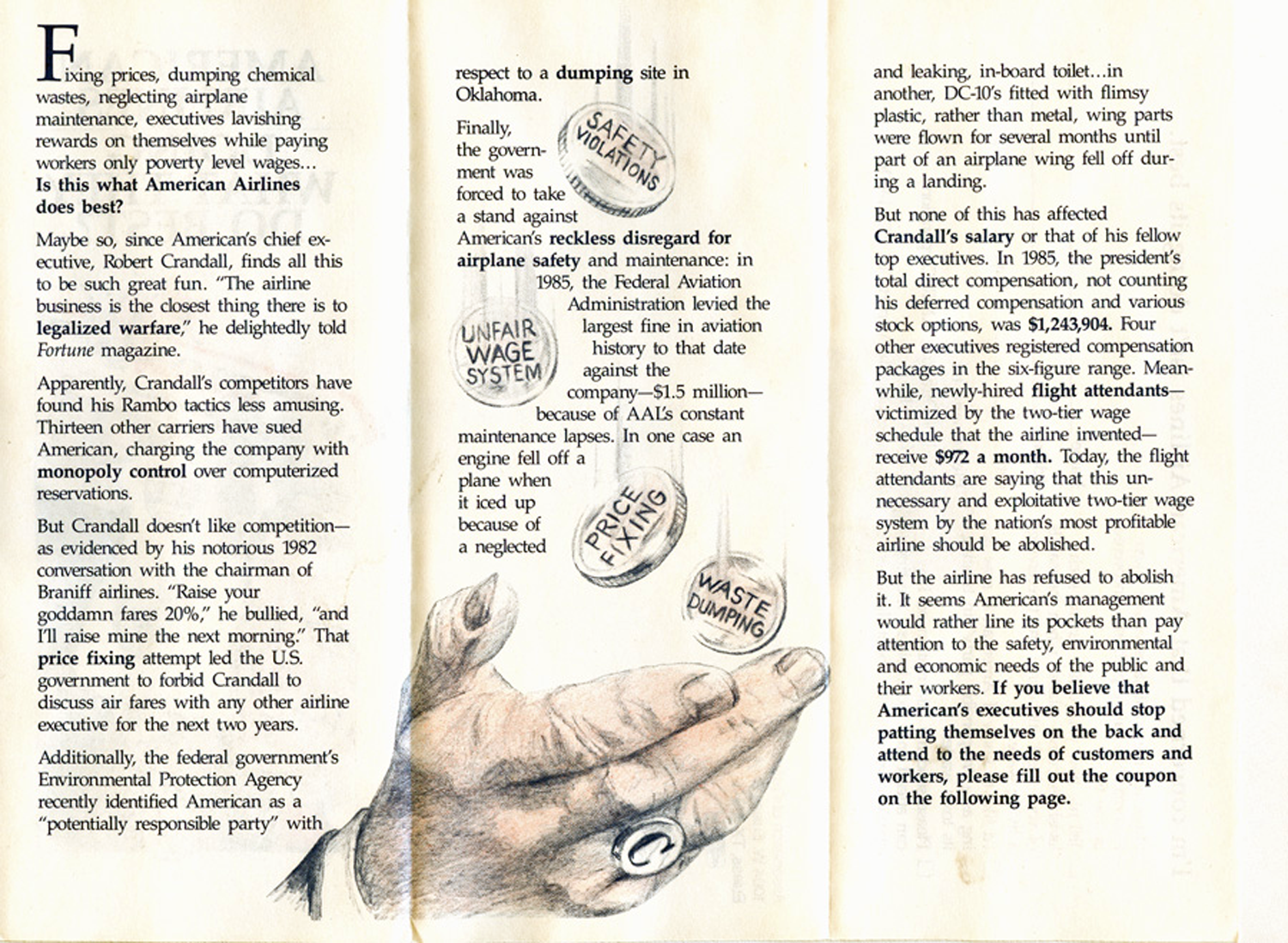
Inside of the CCI Brocure distributed by APFA members fighting to end "B-Scale."
On April 23, 1987, the Dallas Morning News ran a photo of hundreds of protesting flight attendants and supporters marching on Republic Bank behind an APFA banner held by Corporate Campaign Director Ray Rogers and Crystal Lee Sutton, "the real Norma Rae." The accompanying article quoted APFA President Patt Gibbs: "Our two new targets are Republic Bank and Equitable Life Insurance Co." According to the newspaper, "the latest tactic is designed to bring pressure upon corporate relatives of AMR (American Airlines' parent) in hopes they can influence negotiations between the two parties."
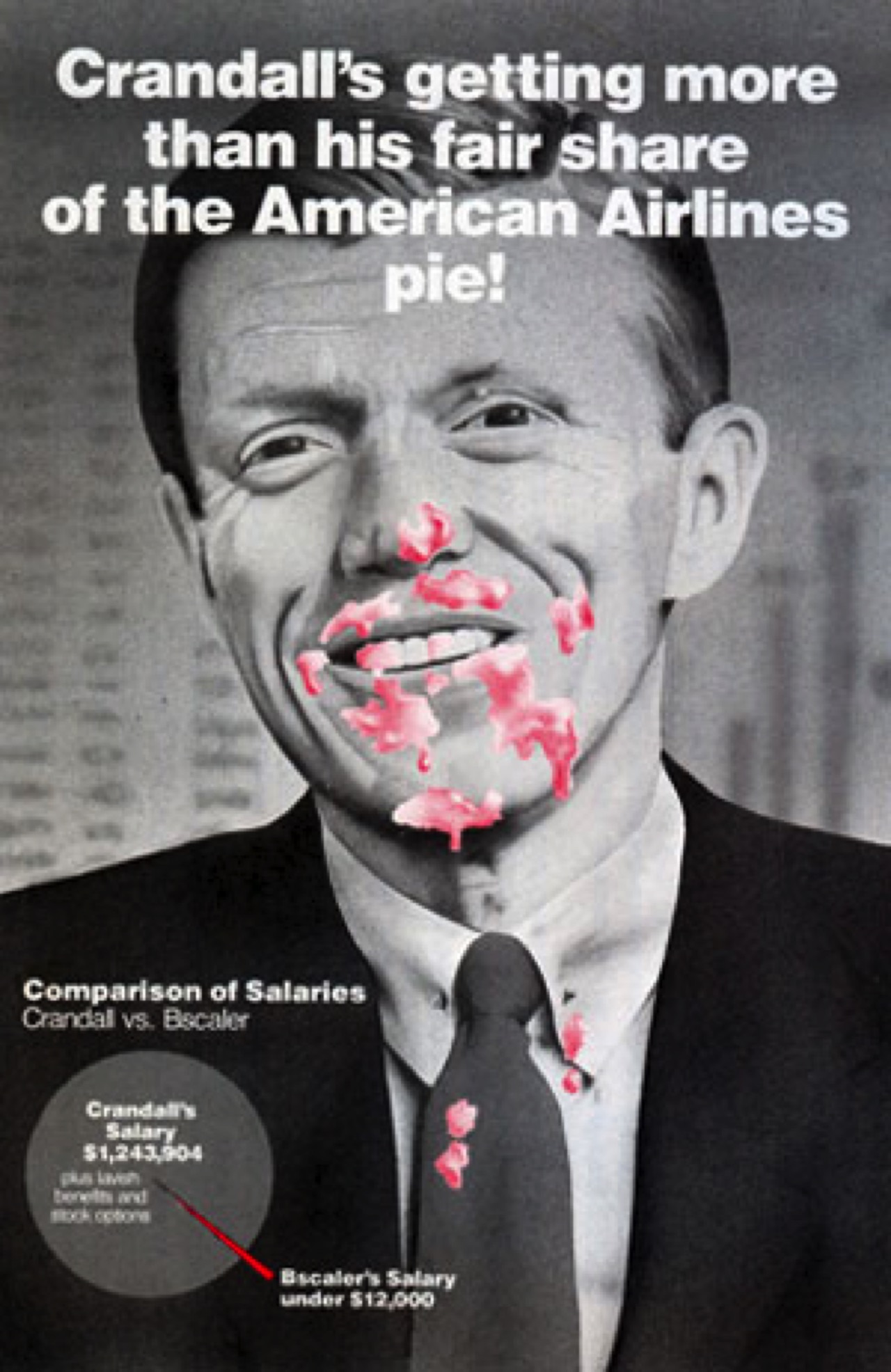
CCI produced illustration for APFA's Skyword magazine.
As APFA was mobilizing for a large protest at AMR's annual meeting in the company's hometown of Dallas, where such meetings had been held each year since 1979, AMR suddenly moved the meeting to North Carolina. Not to be out-maneuvered, Gibbs responded by filling a jet with flight attendants from different bases and flying them to North Carolina to protest at the annual meeting.
Corporate Campaign obtained free office space and phones for APFA at the headquarters of the North Carolina State AFL-CIO. A team of Corporate Campaign staff and APFA members began to organize support locally. Using lists from CCI's database, all unions in the Raleigh-Durham area, as well as dozens of community and religious organizations, were contacted and many joined the demonstration outside the annual meeting. The State chair of the National Organization for Women spoke in the meeting on behalf of a pay equity resolution supporting APFA. Many other union locals and groups that could not attend the meeting showed support by distributing stacks of APFA campaign brochures to their members, printing stories in their newsletters about APFA's struggle and writing protest letters to AMR Chair Robert Crandall.
On April 27, USA Today spotlighted Patt Gibbs and quoted her: "The company is trying to run and hide from the labor problems it has created rather than to bargain fairly to resolve them." The newspaper added, "Ironically, a stockholder resolution on the agenda for this year's meeting proposes moving the meeting site outside Dallas. AMR asks shareholders to oppose it." Over the ensuing months, the campaign expanded and APFA's leadership stood firm.
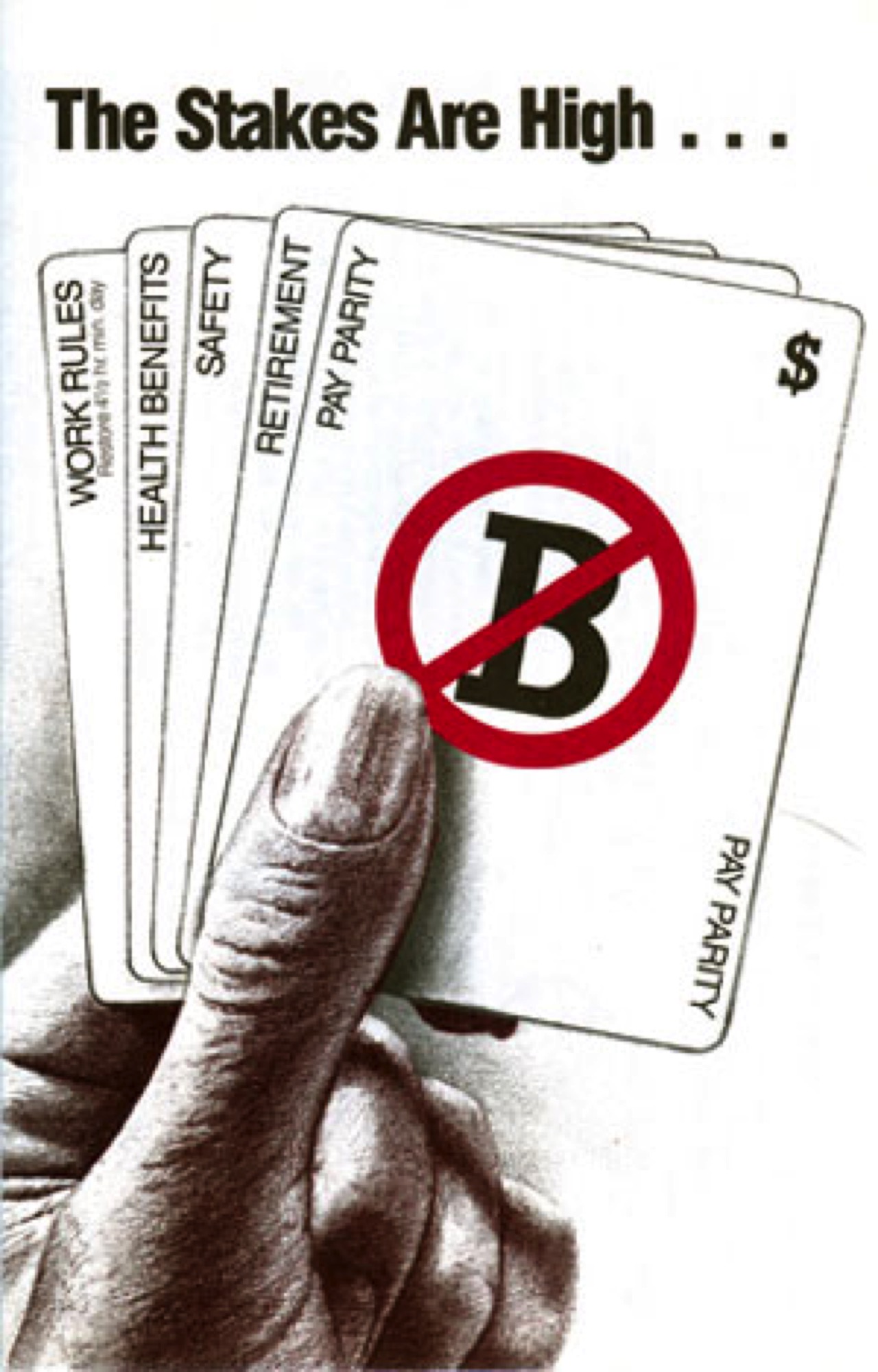
Cover of CCI produced brochure.
Back in February, American had taken a hard line, trying to goad union leaders into making strategic blunders. AMR broke off talks, claiming to the National Mediation Board that it had reached an impasse even though the union was coming back with a revised proposal. On March 11, at the first joint meeting in mediation, AMR gave the union a "take-it-or-leave-it" package. Patt Gibbs responded in a press release: "It is clear that everything AMR has done from the beginning of the negotiations is aimed at forcing an impasse so that they can get the work rule changes they cannot obtain through good faith bargaining. They know our members do not want to strike. We will not put our members in a position where they can be replaced...but we will take whatever steps are necessary to exert the sort of pressures on AMR that are available to us under law."
During the next several months, APFA remained in the news and on the offensive and kept AMR's top policymakers off balance and worrying what the union would do next. Gibbs felt confident enough to call a two-day "solidarity" strike that could have disrupted travel plans for thousands of travelers during the busy Christmas season.
Fortunately, there was no need for a walkout. The Wall Street Journal's headline on Christmas Eve, 1987, proclaimed: "American Air's Flight-Attendant Accord Will End 2-Tier Wage Carrier Pioneered." The story below said that the "surprise, last-minute contract settlement" marked "a significant victory for Patt A. Gibbs, the feisty union leader..."
American Air Attendants Seek to Topple Two-Tier Pay
Carrier Is Resolute in Dispute, Saying It Must Control Costs to Survive
By Marj Charlier And Francis C. Brown III
Staff Reporters | The Wall Street Journal |
March 25, 1987
American Airlines' parent, AMR Corp., is the most profitable airline company in the country, pulling in about 40% of the industry's operating earnings last year.
Nevertheless, American says it can't survive in the current cutthroat climate unless it can keep costs down. And the company vows it will "do what we have to do" to achieve that goal in its current labor dispute with its flight attendants...
But the outcome of the talks, which began in August, also tests American's resolve to hang on to its two-tier wage system, which set the pay of its most junior attendants 37% below that of employees hired before 1983. American pioneered the two-tier scale ...
Test of Corporate Campaign
The American dispute, meanwhile, also is a test of the union's strategy, the corporate campaign, and of the architect of that tool, Ray Rogers, whom the attendants have hired as a consultant...A successful corporate campaign at a union as big as Ms. Gibbs's would be a shot in the arm for labor...
The union decided not to strike the company, a move most labor and industry consultants say is wise. But the union's choice of the corporate campaign and of Mr. Rogers as consultant has raised eyebrows.
Soon after Mr. Rogers's role for the flight attendants was disclosed, American sued the union in federal court in Fort Worth, Texas. In the pending suit, the company alleged that the union, by using a corporate campaign, isn't bargaining in good faith. — Read Article —
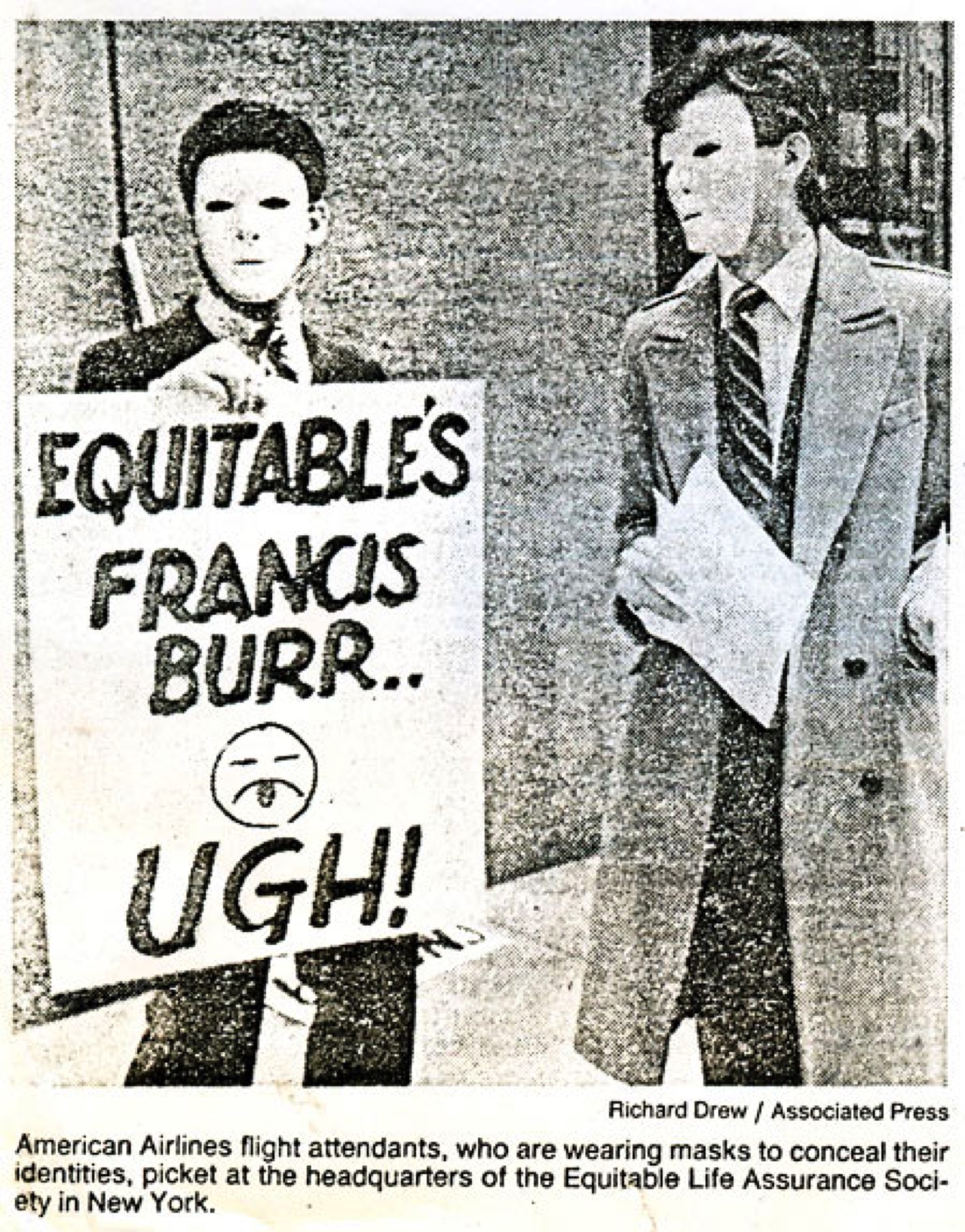
Attendants rip American's two-tier pay
MIKE SHERIDAN | Houston Chronicle |
March 30, 1987
American sought to achieve a reduction in the cost of labor through its two-tier wage plan...
...the plan is now being fought by American's flight attendants, led by the feisty and articulate Gibbs. A 25-year veteran of the airline industry and a longtime union advocate, American has tried to fire Gibbs three times and to discipline her 17 times...
...the union has hired a labor consultant to begin a corporate campaign aimed at American and the carrier's major stockholders. Last week, attendants demonstrated in New York outside the offices of the Equitable Life Assurance Co., which has roughly 12 percent of AMR's stock. — Read Article —
Flight attendants picket Republic Bank
By Kevin B. Blackistone |The Dallas Morning News | April 23, 1987
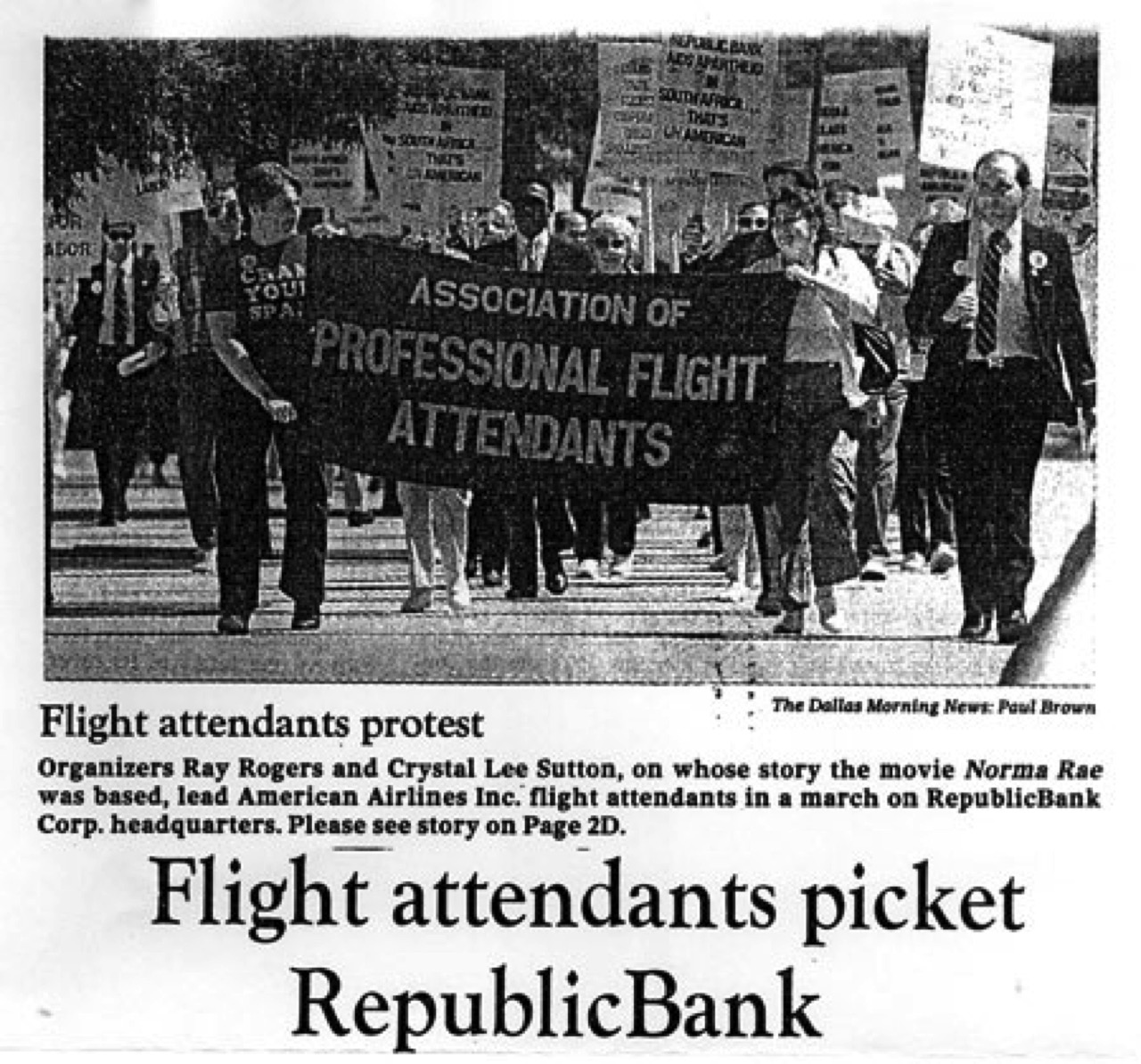
Ray Rogers and Crystal Lee Sutton
(The real Norma Rae) leading a
demonstration of flight attendants
Unionized flight attendants of American Airlines Inc. -- embroiled in a protracted contract dispute with their Dallas-based employer -- introduced a new tactic Wednesday when they picketed the headquarters of Republic Bank Corp., which shares two board directors with the board of AMR Corp., parent company of the airline...
"Our two new target groups are Republic Bank and Equitable Life Insurance Co.," said Patt A. Gibbs, president of the 10,000-member union. "They share a board of directors with American Airlines..."
Earlier Wednesday afternoon, union members and supporters met at the Dallas Convention Center where they heard speeches from Gibbs and officials of other unions.
They also heard from Crystal Lee Sutton, the worker at J.P. Stevens & Co. whose struggle to organize its workers was chronicled in the movie Norma Rae.
"Textile workers and airline workers have something in common," Sutton said. "In our unity lies our strength. Your fight...is important to workers everywhere." — Read Article —
American Air's Flight-Attendant Accord Will End 2-Tier Wage Carrier Pioneered
By Francis C. Brown III | The Wall Street Journal | December 24, 1987
The new pact ends one of the most bitter labor battles in the company's history and marks a significant victory for Patt A. Gibbs, the feisty union leader whom American insisted had lost the support of most of the union's 12,000 members...
Ms. Gibbs yesterday claimed victory in her more than yearlong battle to abolish the company's two-tier wage scale, which pays flight attendants hired since 1983 significantly less than senior flight attendants...
"We didn't cave in," an American spokesman said. "There was some movement on both sides." — Read Article —